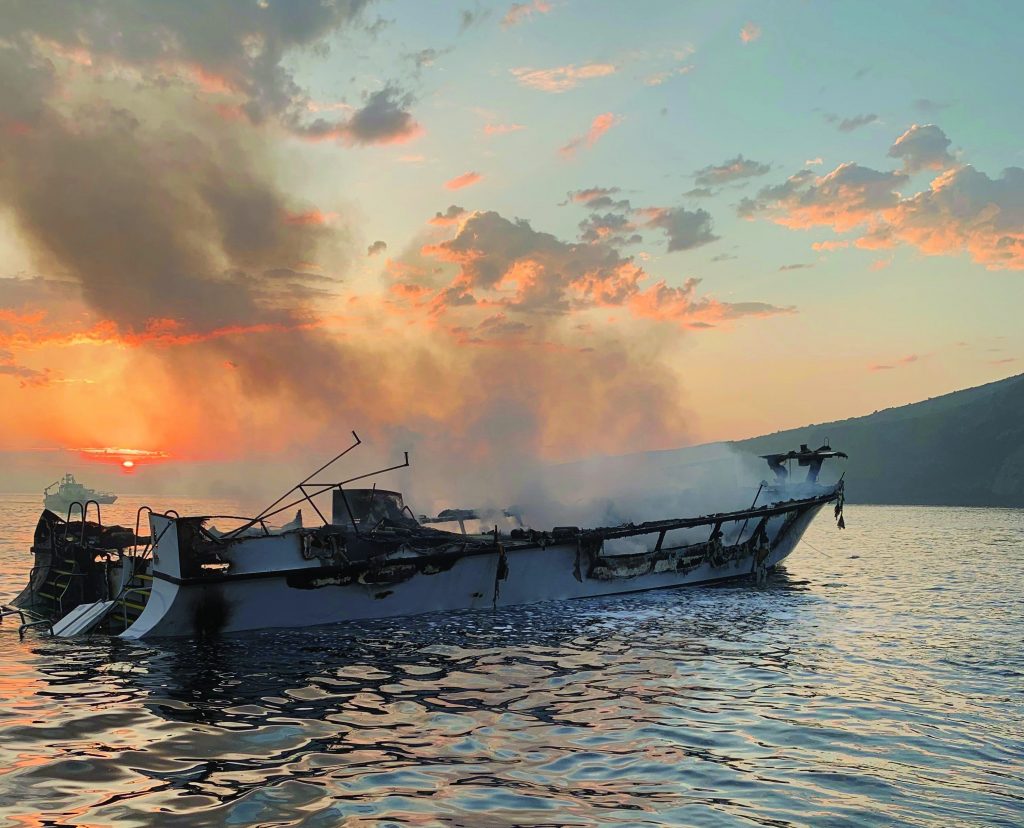NTSB: Night watch could have saved dive boat passengers

The sinking of the dive boat Conception in the Santa Barbara Channel last year and the death of 34 people on board was caused by the failure of Truth Aquatics, the boat’s owner, to properly oversee its vessel and crew, the National Transportation Safety Board ruled on Oct. 20.
The boat, a 75-foot recreational diving vessel, caught fire in the early morning hours of Sept. 2, 2019, when it was anchored just off of Santa Cruz Island. Everyone who was sleeping below deck—33 passengers and one crew member—died of smoke inhalation. Five crew members who were sleeping above deck escaped by jumping off of the boat.
The NTSB could not determine the cause of the fire, due to the extensive damage to the boat. During the Oct. 20 hearing, which was conducted virtually, NTSB investigator Joseph Panagiotou identified a few potential ignition sources, including electric systems, charging batteries for passengers’ cameras and phones, and improperly discarded smoking materials.
The NTSB instead focused its report on the boat’s fire preparedness and the crew’s response, both of which it found lacking.
“The Conception may have passed all Coast Guard inspections, but that did not make it safe,” NTSB Chairman Robert L. Sumwalt said in a news release. “Our new recommendations will make these vessels safer, but there is no rule change that can replace human vigilance.”
The board’s recommendations for small passenger boats similar to the Conception include interconnected smoke detectors in all occupied areas and secondary emergency exits that lead to a different space than the primary exit. The NTSB also recommended that the Coast Guard inspect boats to make sure they have the legally mandated night watch patrol, and that Coast Guard require all boats to have a “safety management system” in place that lays out everyone’s responsibilities in an emergency.
The Conception was required to have a watchman on duty at all times, but there was no one awake when the fire started. By the time the crew woke up and saw the fire, it was too late to fight it or to help get passengers out from below deck, the NTSB said.
The lack of a night watch patrol appears to have been common practice, though the requirement is well known in the boating industry, NTSB investigators found. While the U.S. Coast Guard mandates watch duty, it does not conduct inspections at night and boating companies do not keep logs to verify their compliance. Since 1991, the Coast Guard has issued no citations or fines for failure to post a night watchman.
The boat’s smoke detectors and emergency exits met the legal standards, but proved inadequate to keep the passengers and crew safe, the NTSB said. Interconnected smoke detectors throughout the boat would have allowed the fire to be detected sooner and would have increased the passengers’ chances of survival, the board found.
The bunkroom where the passengers slept had the required two exits, but both opened into the same space, so both were blocked by the fire. The exit hatches from the bunkroom were just 22 inches across, which meets federal requirements for a boat built before 1996, as the Conception was, but would have been inadequate on a newer boat.
The Conception also did not have a safety management system in place, though such a plan is not required. Congress passed a law 10 years ago mandating safety management systems on passenger vessels, but the Coast Guard still does not require them, Sumwalt said.









